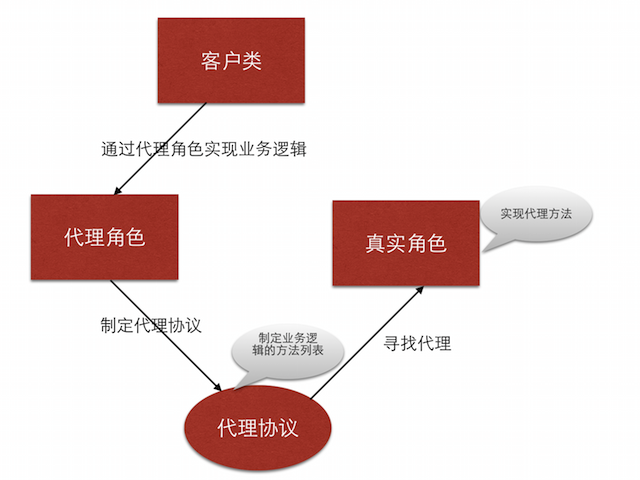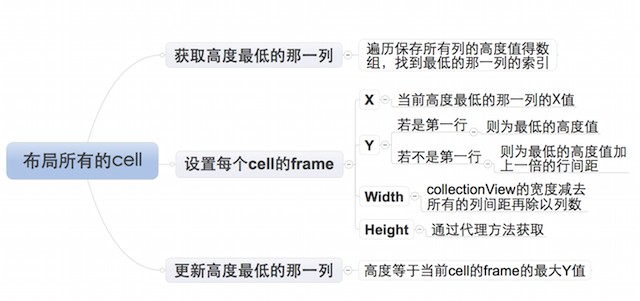
三、自定义布局类的封装
1、业务逻辑
如图

2、布局每个cell的业务逻辑
由于设置每个cell的布局属性的业务逻辑较复杂,特附上如下思维导图

3、封装思路封装需要根据客户类业务逻辑需求来提供接口
1)、通过代理协议的可选实现的方法获取的属性值的属性,需要设置默认值
2)、未提供默认值的且必须使用的属性,需要通过必须实现的方法来获得
3)、自定义布局提供的接口可选
//声明LYPWaterFlowLayout为一个类@class LYPWaterFlowLayout;@protocol LYPWaterFlowLayoutDelegate <NSObject>//必须实现的方法@required/**获取瀑布流每个元素的高度*/- (CGFloat)waterFlowLayout:(LYPWaterFlowLayout *)waterFlowLayout heightForItemAtIndex:(NSInteger)index itemWith:(CGFloat)itemWith;//可选实现的方法@optional/**获取瀑布流的列数*/- (NSInteger)columnCountInWaterFlowLayout:(LYPWaterFlowLayout *)waterFlowLayout;/**获取瀑布流列间距*/- (CGFloat)columnMarginInWaterFlowLayout:(LYPWaterFlowLayout *)waterFlowLayout;/**获取瀑布流的行间距*/- (CGFloat)rowMarginInWaterFlowLayout:(LYPWaterFlowLayout *)waterFlowLayout;/**获取瀑布流的内边距*/- (UIEdgeInsets)edgeInsetsInWaterFlowLayout:(LYPWaterFlowLayout *)waterFlowLayout;@end设置代理属性
@interface LYPWaterFlowLayout : UICollectionViewLayout/**代理*/@property (nonatomic, weak) id<LYPWaterFlowLayoutDelegate> delegate;@end设置通过可选代理方法获取属性值的属性的默认值
/**默认的列数*/static const NSInteger LYPDefaultColumnCount = 3;/**默认每一列之间的间距*/static const CGFloat LYPDefaultColumMargin = 10;/**默认每一行之间的间距*/static const CGFloat LYPDefaultRowMargin = 10;/**默认边缘间距*/static const UIEdgeInsets LYPDefaultEdgeInsets = {10, 10, 10, 10};设置通过可选代理方法获取属性值的属性的访问方式若代理提供属性值,则忽略默认值- (NSInteger)columnCount{//判断代理是否实现了获取列数的可选方法if ([self.delegate respondsToSelector:@selector(columnCountInWaterFlowLayout:)]){//实现,返回通过代理设置的列数return [self.delegate columnCountInWaterFlowLayout:self];}else{//为实现,返回默认的列数return LYPDefaultColumnCount;}}注:其他属性值的获取与上述方法几乎完全相同,不再赘述/**所有cell的布局属性*/@property (nonatomic, strong) NSMutableArray *attrsArray;/**所有列的当前高度*/@property (nonatomic, strong) NSMutableArray *columnHeights;2)、通过懒加载的方式初始化成员属性
/**--attrsArray--懒加载*/- (NSMutableArray *)attrsArray{if (_attrsArray == nil){_attrsArray = [NSMutableArray array];}return _attrsArray;}/**--columnHeights--懒加载*/- (NSMutableArray *)columnHeights{if (_columnHeights == nil){_columnHeights = [NSMutableArray array];}return _columnHeights;}3)、初始化布局- (void)prepareLayout{[super prepareLayout];/**清除之前跟布局相关的所有属性,重新设置新的布局*///清除之前计算的所有列的高度[self.columnHeights removeAllObjects];//设置所有列的初始高度for (NSInteger i = 0; i<self.columnCount; i++){self.columnHeights[i] = @(self.edgeInsets.top);}//清除之前所有的布局属性[self.attrsArray removeAllObjects];/**开始创建每一个cell对应的布局属性*/NSInteger count = [self.collectionView numberOfItemsInSection:0];for (NSInteger i = 0; i<count; i++){NSIndexPath *indexPath = [NSIndexPath indexPathForItem:i inSection:0];//获取indexPath位置cell对应的布局属性UICollectionViewLayoutAttributes *attrs = [self layoutAttributesForItemAtIndexPath:indexPath];//将indexPath位置的cell的布局属性添加到所有cell的布局属性数组中[self.attrsArray addObject:attrs];}}4)、返回包含所有cell的布局属性的数组- (nullable NSArray<UICollectionViewLayoutAttributes *> *)layoutAttributesForElementsInRect:(CGRect)rect{return self.attrsArray;}设置每一个cell的布局属性- (nullable UICollectionViewLayoutAttributes *)layoutAttributesForItemAtIndexPath:(nonnull NSIndexPath *)indexPath{//获取indexPath位置的布局属性UICollectionViewLayoutAttributes *attrs = [UICollectionViewLayoutAttributes layoutAttributesForCellWithIndexPath:indexPath];/**设置cell布局属性的frame*//***确定cell的尺寸***///获取collectionView的宽度CGFloat collectionViewWidth = self.collectionView.frame.size.width;//cell宽度CGFloat width = ((collectionViewWidth - self.edgeInsets.left - self.edgeInsets.right - (self.columnCount - 1) * self.columMargin)) / self.columnCount;//cell高度CGFloat height = [self.delegate waterFlowLayout:self heightForItemAtIndex:indexPath.item itemWith:width];/***设置cell的位置***/NSInteger destColumn = 0;CGFloat minColumnHeight = [self.columnHeights[0] doubleValue];for (NSInteger i = 1; i<self.columnCount; i++){CGFloat columnHeight = [self.columnHeights[i] doubleValue];if (minColumnHeight > columnHeight){minColumnHeight = columnHeight;destColumn = i;}}//计算cell的位置CGFloat x = self.edgeInsets.left + destColumn * (width + self.columMargin);CGFloat y = minColumnHeight;//判断是不是第一行if (y != self.edgeInsets.top){//若不是第一行,需要加上行间距y += self.rowMargin;}/**给cell的布局属性的frame赋值*/attrs.frame = CGRectMake(x, y, width, height);//更新最短那列的高度self.columnHeights[destColumn] = @(CGRectGetMaxY(attrs.frame));/**返回indexPath位置的cell的布局属性*/return attrs;}5)、设置collectionView内容的尺寸- (CGSize)collectionViewContentSize{//获取最高的那一列的高度CGFloat maxColumnHeight = [self.columnHeights[0] doubleValue];for (NSInteger i = 1; i<self.columnCount; i++){CGFloat columnHeight = [self.columnHeights[i] doubleValue];if (maxColumnHeight < columnHeight){maxColumnHeight = columnHeight;}}//返回collectionView的contentSize,高度为最高的高度加上一个行间距return CGSizeMake(0, maxColumnHeight + self.rowMargin);}以上就是本文的全部内容,希望对大家的学习有所帮助。